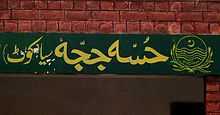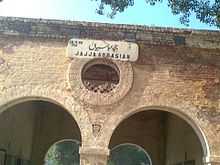Jajja

| Jajja | |
|---|---|
| Jat Clan | |
| Location | Punjab (Pakistan) and Punjab (India) |
| Language | Punjabi |
| Religion | Islam and Sikhism |
| Surnames | Jajja |
The Jajja are a group of Jats found in the Punjab province of Pakistan.
History,origin and demography
Jajja was one of the kings of Kashmir (748-751 AD) who basically belonged from Punjab region. According to some historians his ruling period extended between 782-785 AD. He was the brother in law of King Jayapida. He usurped the throne of Kashmir from Jayapida in 748 AD. In a fierce contest near Suskaletra in the Kashmir valley, Jajja was vanquished and slain after having had the possession of the land for three years.[1][2][3][4][5][6][7][8][9][10][11]

His descendants are known as Jajjas. They bear the surname of Jajja proudly after the name of their forefather Jajja. They are famous for their bravery and unity. They are basically farmer fighters and are known to have extreme affection towards their clan and motherland. There are twelve villages of Jajjas near Qila Kallar Wala in District Sialkot of Pakistan, all named after 12 sons of father Jajja. These twelve sons settled near fertile lands of Qila Kallar Wala after conquering vast stretches of lands from local landlords. Khan Jajja,Geo Wali jajjah Hussa Jajja, Lodi Jajja, Mohri Kay Jajja, Fateh Pur Jajja, Kot Agha Jajja, Ucha Jajja, Ghano Kay Jajja are few among those 12 villages. There is also a village named Jajja Kalan in India. In fact,Jajjas are spread all over Punjab including Jajja Jajja, a village near Rawalpindi and Southern Punjab including Bahawalpur. Derawar Fort is believed to be constructed by Jajjas which was later conquered by Abbasi rulers of Bahawalpur. Later they form alliance and Jajja Abbassian town was constructed which is present even today near Rahimyar Khan and some of their family are in Distt. Rajan pur (southern Punjab)and they migrate from Sialkot later and is famous for delicious dates. All of these Jajjas are descendants of father Jajja who moved from Kashmir.
References
- ↑ Kalhana's Rajatarangini:A chronicle of the Kings of Kashmir by Kalhana page 94, 136, 169
- ↑ Encyclopaedia of Untouchables: Ancient Medieval And Modern by Raj Kumar page 40, 142, 147,148, 386
- ↑ Volume 2 Appendix THE KARKOTA DYNASTY
- ↑ A Comprehensive History of India Pt. 1. A.D. 300-985
- ↑ Asiatick researchers,or, Transactions of the society instituted..., Volume 15 by Asiatick Society (Calcutta, India)Page 54,81,
- ↑ Culture and Political History of Kashmir: Ancient Kashmir, Medieval Kashmir by P.N.K Bazmi Page 118, 136, 221
- ↑ History of The Chamar Dynasty: (From 6th Century A.D. to 12th Century A. D. by Raj Kumar Page 91, 106)
- ↑ Indian Kavya Literature, Volume 4 by A. K. Warder Page 467
- ↑ Introduction, Books 1-7 by Sir Aurel Stein Page 94, 136, 159, 163, 169, 173
- ↑ Kings of Kashmira, Volume 3 by Suka, Srivara, Prajabhatta, Jonaraja Page 89, 92, 97
- ↑ Stories from Rajatarangini: Tales of Kashmir by Devika Rangachari Page 77, 78